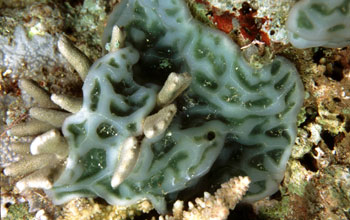Multimedia Gallery
Lissoclinum patella Ascidian
Lissoclinum patella (Gottschaldt, 1898) in the Spermonde Archipelago, southwestern Sulawesi, Indonesia. This species is one of the most studied ascidians because of its bioactive metabolites and natural products, which may be of great pharmaceutical value for a range of human diseases. In this image, you can see that the L. patella colony is overgrowing living corals. Although few coral reef organisms are able to overgrow living corals, the L. patella colony seen here is able to do so, probably--at least in part--because of its bioactive chemicals.
Ascidians are animals that live in seawater. In the early stage of life, they look like a tiny fish with a tail that they use to swim around until they have located a spot to settle down. As soon as they settle, they lose their tail and fasten themselves on the substratum, growing and living the remainder of their life as a sessile animal. Ascidians have a kind of heart, blood, muscles, "lung" and stomach, just as most animals do.
There are two groups of ascidians: solitary and colonial. If you were to examine with a microscope, the insides of an Ascidian from the colony type, you would see many small, individual ascidians. (Date of Image: June 2000)
Note: Please see "Special Restrictions" at bottom of page regarding use of this image.
Credit: Adriaan Gittenberger (www.ascidians.com)
See other images like this on your iPhone or iPad download NSF Science Zone on the Apple App Store.
Special Restrictions: In principal, this image can be used on a royalty-free basis for non-commercial purposes by universities, museums, schools and NSF funded projects, as long as the credit "Adriaan Gittenberger, www.ascidians.com" is added and the photographer is notified (gittenberger@yahoo.com). In case of a publication that is available to the general public, Adriaan Gittenberger would like to receive a hardcopy issue/reprint (or the Web address when it is used on the internet only). For commercial purposes like the production of a field guide, pleas contact (gittenberger@yahoo.com.
Images and other media in the National Science Foundation Multimedia Gallery are available for use in print and electronic material by NSF employees, members of the media, university staff, teachers and the general public. All media in the gallery are intended for personal, educational and nonprofit/non-commercial use only.
Images credited to the National Science Foundation, a federal agency, are in the public domain. The images were created by employees of the United States Government as part of their official duties or prepared by contractors as "works for hire" for NSF. You may freely use NSF-credited images and, at your discretion, credit NSF with a "Courtesy: National Science Foundation" notation.
Additional information about general usage can be found in Conditions.
Also Available:
Download the high-resolution JPG version of the image. (2.6 MB)
Use your mouse to right-click (Mac users may need to Ctrl-click) the link above and choose the option that will save the file or target to your computer.



